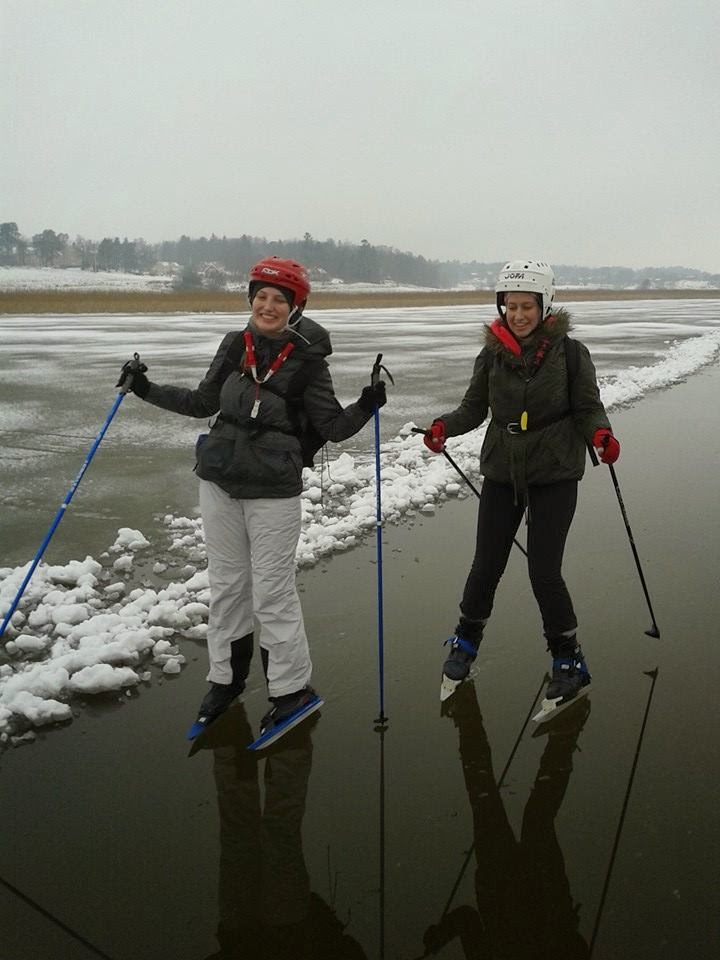
This is Britta Röjås, the woman who taught our kulning course.
Kulning is a Swedish folk tradition that roughly translates to "herding calls" in English, I think. There aren't any words in English that can really describe what kulning is but if you imagine a mix of yodeling and opera singing, that's sort of what it sounds like. Kulning is a musical technique that is used to call livestock home from distant pastures. Kulning is very high-pitched and thus the sound is able to travel long distances. Kulning often sounds quite eerie and sad, but also loud and powerful.
It is almost impossible to describe if you've never heard it before. If done properly, the strength behind the singing will come from the stomach and not the throat, although this technique is difficult to master. Kulning often follows the melody of a song, but what differentiates kulning from singing is that you don't sing any words, just the melody of the song.
This is how I imagine kulning would look if done traditionally. This is also one of the first images that appears if you Google kulning. But it gives an idea of what I'm writing about.
Kulning is not just music, it is used to communicate important messages between livestock herders. An example of this would be a melody I learned this weekend: "Lever du? Lever du? Ja' trodde du var långa långa död", which in my head translates to: " Are you alive? Are you alive? I thought you were long, long dead". Another example is " Leta ej mer, leta ej mer, korna e hemma" which in my head translates to: " Look no more, look no more, the cows are home". I can't guarantee that either of my lyric translations are accurate, but the idea comes across, just how important the melody is to kulning. Kulning is a tradition that has been used in livestock raising since medieval times. Kulning is not as prevalent today, but it is still significant.
Now that I've explained kulning, it's possible to understand how great my weekend was. But this weekend was not my first experience with kulning. I also attended a one day kulning course in November with Monika, also taught by Britta. That was my first experience with kulning. I thought it was challenging, but ultimately rewarding and fun! Here are some pictures from the course in November:

Britta teaching us the basics.

It's all about attitude

And being expressive

Britta is the queen of attitude and kulning. She's wonderful.
In January, Monika and I organized our very own kulning course. We gathered in Lugnet in the afternoon with about 20 people including my first host family and their relatives from Stockholm and Uppsala, my second host family, and my fellow exchange student Beth. Monika remembered a lot more of the details from our course in November and she bravely taught all of us the kulning basics. I was the assistant teacher, for sure.
Beth and I had a lot of fun with our torches during our kulning promenade.
After the lesson, we split into two groups: one group walked to Sunnerstabacken (the ski hill in Uppsala) and the other group walked along the river until we were across from Sunnerstabacken, but on the other side of the river. We had lit torches and we did kulning for each other, and got quite a few strange looks from passers by. After our outdoor kulning evening, we all walked together back to my first host family's house and we had a lovely potluck dinner together.
Our kulning party in January was such a great experience, I could hardly wait for the 2-day kulning course in February. Ulrika, Monika, and I had a blast together on Saturday and Sunday working on our kulning skills. We sang, practiced kulning, and laughed. This past weekend was absolutely terrific and it was an exprience I will certainly never forget.
Thank you Monika for the photos of Britta!

.JPG)
.JPG)




